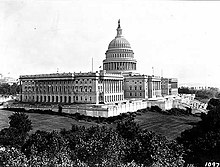67th United States Congress
| 67th United States Congress | |
|---|---|
|
66th ←
→ 68th
|
|

United States Capitol (1906)
|
|
| March 4, 1921 – March 4, 1923 | |
| Senate President | Calvin Coolidge (R) |
| Senate Pres. pro tem | Albert B. Cummins (R) |
| House Speaker | Frederick H. Gillett (R) |
| Members | 96 Senators 435 Representatives 5 Non-voting members |
| Senate Majority | Republican |
| House Majority | Republican |
| Sessions | |
|
Special: March 4, 1921 – March 15, 1921 1st: April 11, 1921 – November 23, 1921 2nd: December 5, 1921 – September 22, 1922 3rd: November 20, 1922 – December 4, 1922 4th: December 4, 1922 – March 3, 1923 |
|
The Sixty-seventh United States Congress was a meeting of the legislative branch of the United States federal government, consisting of the United States Senate and the United States House of Representatives. It met in Washington, D.C. from March 4, 1921 to March 4, 1923, during the first two years of Warren Harding's presidency. The apportionment of seats in the House of Representatives was based on the Thirteenth Census of the United States in 1910. Both chambers had a Republican majority.
The count below identifies party affiliations at the beginning of the first session of this Congress, and includes members from vacancies and newly admitted states, when they were first seated. Changes resulting from subsequent replacements are shown below in the "Changes in membership" section.
TOTAL members: 435
This list is arranged by chamber, then by state. Senators are listed in order of seniority; Representatives are listed by district.
Senators were elected every two years, with one-third beginning new six-year terms with each Congress. Preceding the names in the list below are Senate class numbers, which indicate the cycle of their election. In this Congress, Class 1 meant their term ended with this Congress, requiring reelection in 1922; Class 2 meant their term began in the last Congress, requiring reelection in 1924; and Class 3 meant their term began with this Congress, requiring reelection in 1926.
(10 Democrats)
(1 Democrat)
(7 Democrats)
(9-2 Republican)
(3-1 Republican)
(5 Republicans)
(1 Republican)
(4 Democrats)
(12 Democrats)
(2 Republicans)
(24-3 Republican)
(13 Republicans)
(11 Republicans)
(8 Republicans)
(8-3 Democratic)
(8 Democrats)
(4 Republicans)
(4-2 Republican)
(14-2 Republican)
(13 Republicans)
(10 Republicans)
(8 Democrats)
(14-2 Republican)
(2 Republicans)
...
Wikipedia
